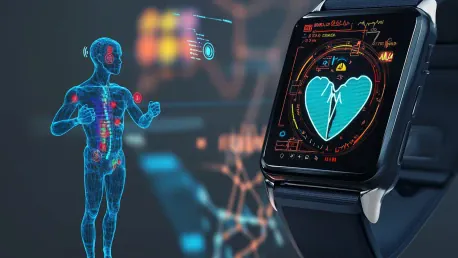The rapid advancements in smartwatches and fitness trackers have revolutionized healthcare monitoring and diagnosis, marking significant progress since their inception. Initially launched with the Fitbit in 2007, these devices have undergone considerable evolution, now boasting a variety of sensors and advanced capabilities. Today, experts predict that with AI-driven analysis, smartwatches and fitness trackers will soon diagnose more diseases than doctors, bridging gaps in healthcare and offering unprecedented health insights. This transformation heralds a new era in health monitoring, driven by continuous technological advancements and the integration of AI.
Evolution of Smartwatches in Healthcare
Smartwatches have come a long way since their initial launch, morphing from simple fitness trackers into comprehensive health monitoring tools. The inception of devices like the Fitbit and the Apple Watch signaled the start of a transformative era in health technology. Since its debut in 2015, the Apple Watch has sold over 100 million units, underscoring its significant impact on health monitoring. Key additions such as ECGs introduced in 2018 and oxygen saturation sensors in 2020 have turned these devices into indispensable tools, capable of providing continuous health data that is crucial for early detection and timely intervention.
The significance of these advancements was brought to the forefront during the COVID-19 pandemic. The ability to continuously monitor lung function and other vital signs became especially crucial in tracking the health of individuals affected by the virus. These insights have demonstrated the essential role wearable technology plays in not only managing existing health conditions but also in providing real-time health data that can inform both patients and healthcare providers. The journey from basic fitness tracking to advanced health monitoring marks a pivotal shift in how health data is captured and utilized.
Data-Driven Health Awareness
One of the most profound benefits of smartwatches and fitness trackers is the wealth of health data they generate, which surpasses traditional intermittent clinical observations. Dr. Matthew Ahmadi of the Mackenzie Wearables Research Hub at Sydney University highlights that this data can greatly inform both clinicians and individuals about their health. This constant flow of data fosters greater health awareness, promoting proactive measures to manage health conditions. Today’s wearables provide continuous health information that enhances the monitoring and management of patient health, shifting the paradigm from reactive to proactive healthcare management.
However, it is important to note that not all data generated by these devices is always accurate or substantiated by evidence. Some metrics may serve more to market the devices rather than offer meaningful health insights. Despite these discrepancies, the potential for wearables to predict future health events through smart algorithms is a promising development. As the technology becomes more sophisticated, the accuracy and reliability of the health data are expected to improve, making these devices even more valuable in daily health management and disease prevention.
Predictive Health Monitoring
Wearables are transitioning from devices that merely track past activities to tools that predict future health events with growing sophistication. Smart algorithms embedded in these devices detect subtle changes in vital signs, such as resting heart rates, offering predictions that can forewarn users of potential serious conditions like atrial fibrillation (AF). This predictive capability is a game-changer, leading to early interventions that have the potential to save lives. It exemplifies how wearable technology can move beyond retrospective tracking to proactive health management, capturing real-time data to anticipate and address health issues before they escalate.
The cultural appropriateness and utility of wearables have been further demonstrated through research by the University of NSW involving Indigenous NT elders. The study highlighted that these devices not only provided comfort and convenience but were also culturally safe for monitoring heart health. Wearables detected AF in participants, leading to lifesaving interventions. This example underscores the potential of wearables to bridge gaps in healthcare accessibility, especially in remote areas. It also highlights their capability to deliver timely health insights, fostering better health outcomes across diverse populations.
Future Trends and Technological Advancements
The future of wearable technology in healthcare looks increasingly promising with the anticipated integration of AI large language models (LLMs). These models are designed to analyze extensive amounts of physiological data and contextual information, thus offering deeper health insights and more sophisticated decision-making capabilities. The integration of LLMs with wearables will significantly enhance their proactivity and relevance in health monitoring, making them more adept at predicting and managing health conditions.
Furthermore, upcoming technological advancements promise new sensors that could monitor blood pressure and glucose levels, which would be indispensable for managing chronic conditions like hypertension and diabetes. Emerging nanotechnologies are also on the horizon, developing biosensors capable of detecting hazardous substances, medication concentrations, and indicators of stress and disease in bodily fluids. These advancements will further expand the capabilities of wearables, making them even more integral to healthcare monitoring and disease prevention.
Challenges and Regulatory Issues
Despite the immense promise that wearables hold for transforming healthcare, several challenges and regulatory issues remain to be addressed. Regulatory barriers have delayed the availability of certain health features, such as using Apple’s AirPods Pro 2 as hearing aids in Australia. This demonstrates the complexities involved in bringing new health technologies to market, where each innovation must navigate a thorough process to ensure safety and efficacy. Additionally, the misleading claims by some companies that their online devices can measure blood glucose levels highlight the potential health risks and the need for stringent regulatory scrutiny.
The integration of AI into healthcare data also presents significant concerns, particularly regarding privacy regulations. Ensuring the privacy and security of health data is paramount, as wearable devices become more ingrained in healthcare systems. Stringent privacy laws must be adhered to, protecting sensitive health data from potential breaches. Addressing these challenges will be crucial for the continued growth and adoption of wearable technology in healthcare. Overcoming them will require concerted efforts from policymakers, technology developers, and healthcare providers.
Enhancing Health Literacy and Proactive Healthcare Management
The rapid advancements in smartwatches and fitness trackers have dramatically transformed healthcare monitoring and diagnosis. These devices have made remarkable progress since the launch of the first Fitbit in 2007. Over the years, they have evolved significantly, incorporating a variety of sensors and advanced features. Today, experts believe that with the integration of AI-driven analysis, smartwatches and fitness trackers will soon be able to diagnose more diseases than doctors can, filling gaps in healthcare and providing groundbreaking health insights. This shift signifies a new era in health monitoring, characterized by continuous technological advancements and artificial intelligence integration. As these technologies progress, they hold the potential to revolutionize the accessibility and accuracy of personal health monitoring. The improvement in wearable technology promises not only more comprehensive health data but also more accurate and timely medical intervention, enhancing overall healthcare outcomes and personal well-being.









